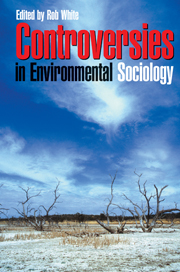Book contents
- Frontmatter
- Contents
- Tables and Figures
- Author Notes
- Abbreviations
- Introduction: Sociology, Society and the Environment
- PART I SOCIAL PERSPECTIVES
- PART II SOCIAL TRENDS
- PART III SOCIAL ISSUES
- 12 Moulding and Manipulating the News
- 13 Agricultural Production and the Ecological Question
- 14 Pathological Environments
- 15 Assessing the Social Consequences of Planned Interventions
- 16 Criminology, Social Regulation and Environmental Harm
- Index
- References
14 - Pathological Environments
Published online by Cambridge University Press: 05 June 2012
- Frontmatter
- Contents
- Tables and Figures
- Author Notes
- Abbreviations
- Introduction: Sociology, Society and the Environment
- PART I SOCIAL PERSPECTIVES
- PART II SOCIAL TRENDS
- PART III SOCIAL ISSUES
- 12 Moulding and Manipulating the News
- 13 Agricultural Production and the Ecological Question
- 14 Pathological Environments
- 15 Assessing the Social Consequences of Planned Interventions
- 16 Criminology, Social Regulation and Environmental Harm
- Index
- References
Summary
The environments within which people live and work are not the benign settings we often assume them to be. Some of them are, to differing degrees and for a variety of reasons, potentially pathological. In those parts of the world where the population lacks access to a safe supply of drinking water and adequate waste disposal facilities, for example, diarrhoeal diseases and respiratory tract infections continue to exact a large toll on human health. The persistence of such environmentally related communicable diseases, along with the outbreaks of new ones such as BSE, Ebola, and SARS, makes the claims of the 1960s and 1970s that modern medicine had conquered infectious disease ring increasingly hollow. Meanwhile, the proportion of the global burden of non-communicable disease and injury linked, at least in part, to environmental causes is also on the rise. Work-related injuries and cancers, lung damage from indoor and outdoor air pollution, the rising number of antibiotic-resistant bacterial diseases, and mounting evidence linking neurobehavioural disorders in children to exposure to lead and other toxic chemicals all indicate that the environments in which we live, work, learn, and play can pose serious risks to our health.
What factors account for these trends? Does the increase in environmentally related health risks reflect an underlying increase in the pathogenicity of certain environments, or are specific patterns of human social interaction within those environments instead to blame? Does the rising environmental health toll reflect heightened human awareness of, or perhaps increased vulnerability to, such risks?
- Type
- Chapter
- Information
- Controversies in Environmental Sociology , pp. 238 - 256Publisher: Cambridge University PressPrint publication year: 2004



